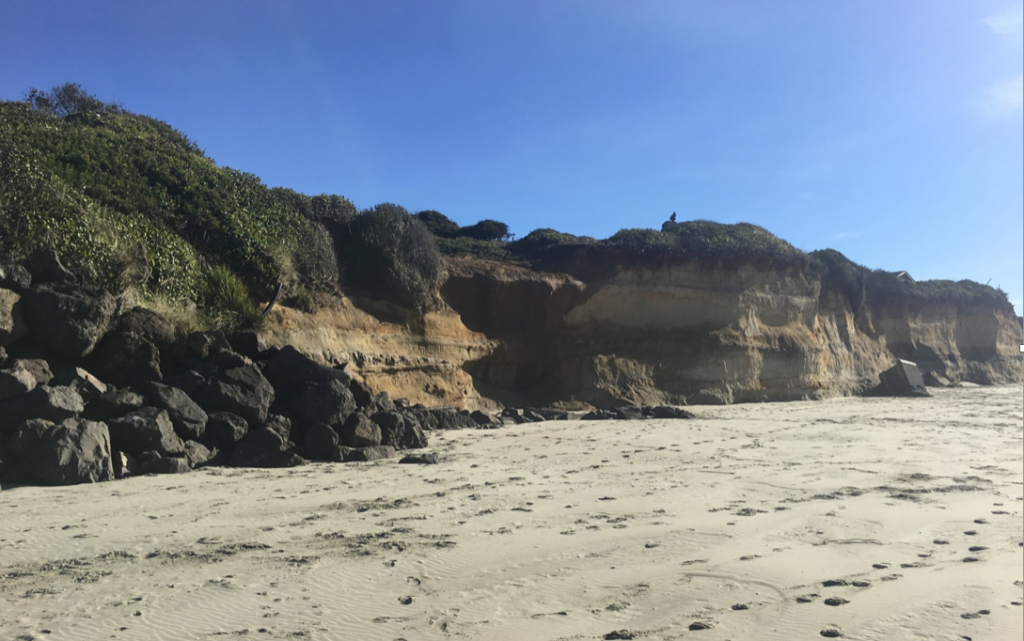
By STEVE LUNDEBERG/OSU News Service
Unstable slopes on Oregon’s coastline could see a 30 percent jump in landslide movements if extreme storms become frequent enough to increase seacliff erosion by 10 percent, a new study by Oregon State University shows.
For many slope failures along U.S. Highway 101, these cliffs form the base of active slides that already move a little every year, said the study’s corresponding author, Ben Leshchinsky, a forest engineering and civil engineering researcher at OSU.
The findings are especially impactful for slides along the 360-mile-long coastline that are highly susceptible to “toe erosion” – the removal of buttressing material at the base via waves or scouring by rivers.
“The really big slides, the monstrous landslides that span hundreds of acres, are so large and driven by water that their instability is less dominated by erosion,” Leshchinsky said. “But the ones that are highly exposed to erosion from the ocean, if we see increased extreme events like storm surge, then we’ll see increased bluff erosion. These creeping landslides that are already active and moving every year, they’ll move a lot more. If erosion increases 10 percent, slide movements might increase by 20 or 30 percent.”
Also known as slow earthflows, the slides are prone to gradual movement, the result of being marginally stable to begin with, coupled with seasonal changes in the water pressure within their soil.
Fluctuations in groundwater levels are primarily what drive changes in that water pressure and in turn landslide movement, but undercutting and “toe retreat” also play key roles, Leshchinsky said. As a bluff’s toe erodes, the soil in the bluff shifts gradually – sometimes ending in collapses that can topple houses and bury roads.
“What’s going on may often be imperceptible until a landslide begins to compromise infrastructure like underground utilities or roads,” he said.
Leshchinsky and collaborators developed a model to determine the relationship between progressive landslide movement and slope geometry, undercutting processes and hydrological changes. The model showed agreement with data gathered at three monitored slide sites along Oregon’s shoreline.
“The smaller progressive slides are particularly sensitive to movements and undercutting,” he said. “Our model shows the shorter-length landslides are proportionately more destabilized by the removal of buttressing materials.”
Landslides demonstrate sensitivity to changes in erosion rates, he said, highlighting the potential impacts of bigger waves or river runoff – both of which could be exacerbated by a changing climate.
Options for decreasing erosion include dune-stabilizing vegetation where applicable, seawalls, riprap and revetments.
Revetments are sloping structures placed some distance from a bluff. They are designed to absorb wave energy before it hits the bluff. Newer armoring technology, like dynamic revetments, characterized as cobbles placed along the toe of sea cliffs, have also been used to absorb wave energy, but require significant quantities of material and frequent maintenance.
Riprap refers to large, loose boulders; placed at the toe of a bluff, it provides stability in the manner of a flying buttress. But its use in Oregon was severely restricted in the early 1970s by the state legislature, which sided with critics who called it an eyesore that ruined beaches and caused erosion elsewhere.
“There is some truth that riprap, by virtue of preventing erosion in a given location, may shift erosion elsewhere and slows the creation of new sand, which often comes from the sea cliffs failing and degrading into new sand,” Leshchinsky said. “However, in limited, controlled applications to conserve exposed critical infrastructure, the benefits may outweigh the cost.”





















I had heard that riprap is no longer being done, but I didn’t know why. Thanks for explaining this idea.